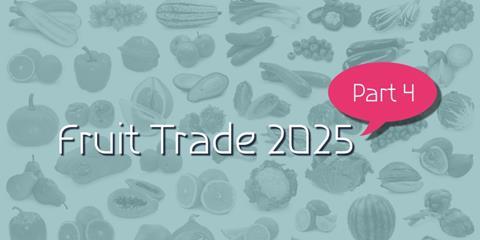
You may well have noticed there is more of a buzz around fresh produce in many of the world’s major consumer markets, and it’s a feeling that simply wasn’t there just a few years ago. Fruit and vegetables are suddenly being viewed more and more for what they are: foods that are potentially very beneficial in terms of health, as well as exciting in terms of pure enjoyment. Some would go as far as to say that fruit and veg are now a great deal more fashionable – yes, we spotted those fruity models on the catwalks too – and perhaps, as new research from the US suggests, in certain instances they might even be regarded by consumers as ‘sexy’.
This is a major trend that features prominently in Part 4 of Fruit Trade 2025, a special report prepared by leading Swiss think-tank the Gottlieb Duttweiler Institute and released free of charge by leading industry trade fair Fruit Logistica, in collaboration with Fruitnet Media International.
Download your copy of Fruit Trade 2025: Part 4 — Consumers, from the Fruit Logistica website
While demand clearly isn't rising for all products, an overall increase in the popularity of fresh fruit and vegetables – especially items like avocados, blueberries and sweet potatoes – is thanks in no small part to a sudden and enormous surge in consumer interest among the millions of people on social media who have latched on to the idea of produce as a source of wellness. Many of the digital world’s self-appointed lifestyle gurus and healthy eating champions might be accused of simply making hay while the sun shines on their own chosen area of expertise, but it’s also important to recognise that this is where much of the generic marketing is being done right now on behalf of the fresh produce business; it’s not funded by companies in the industry itself, it’s coming from bloggers, instagrammers, tweeters, snapchatters and a whole cohort of other digitally engaged individuals.
So, what conclusions might be drawn by those in the fresh produce business who want to benefit from the feast of commercial nutrition that this new trend promises to serve up? The answer, at least as far as Fruit Logistica’s recently published Fruit Trade 2025 report is concerned, is that suppliers will have to respond to changes in consumer demand that will happen far more rapidly than before. The trend might well be positive, but successfully riding the wave of fruit and vegetables’ increased popularity isn’t as simple as allowing it to wash over you. To stretch the analogy somewhat, what’s required is the right vessel with all of the right equipment on board. For example, taming the social media beast is a major challenge. Yes, viral campaigns can attract big audiences at a remarkably low price, but it’s also very difficult to plan and control this kind of campaign.
New demand, new demands
While health is clearly the driving force behind the fresh produce trade’s recent acceleration, suppliers and marketers that have established their reputation in terms of quality and food safety are now under new pressure from consumers to deliver in other areas, most notably sustainability and transparency via things like organic or fair-trade products. The associated opportunities are clear: consumers benefit, but producers and the environment also benefit. But of course, the bar is set higher as a result, and the pressure to maintain those new standards won’t disappear.
That’s not to say, however, that all consumers are prepared to sacrifice the convenience they have come to expect in return for healthier, more ethically sound and more sustainably sourced products. Not everyone is prepared to rise at the crack of dawn, whizz up a veggie smoothie in their NutriBullet and run headlong through a day’s work punctuated by menu stops replete with healthy, hip and home-made food. On the contrary, as the Fruit Trade 2025 report observes, “many feel that eating a healthy diet requires too much effort and time, and is also rather complicated”. As a result, there are plenty of opportunities to confound those expectations with products and services such as home delivery schemes that help consumers get fresh produce into their diets easily.
Fruitnet has spent the past few months serialising Fruit Logistica’s Fruit Trade 2025 report and the response has been very positive indeed. As we publish the fourth and final part, which focuses on consumers, it’s fair to say that interest in where the fresh produce business is heading over the next few years is reassuringly high. The fact that so many people in the industry want to use such a resource bodes well for the future success, not to mention health and sustainability, of the trade as its journey continues.



